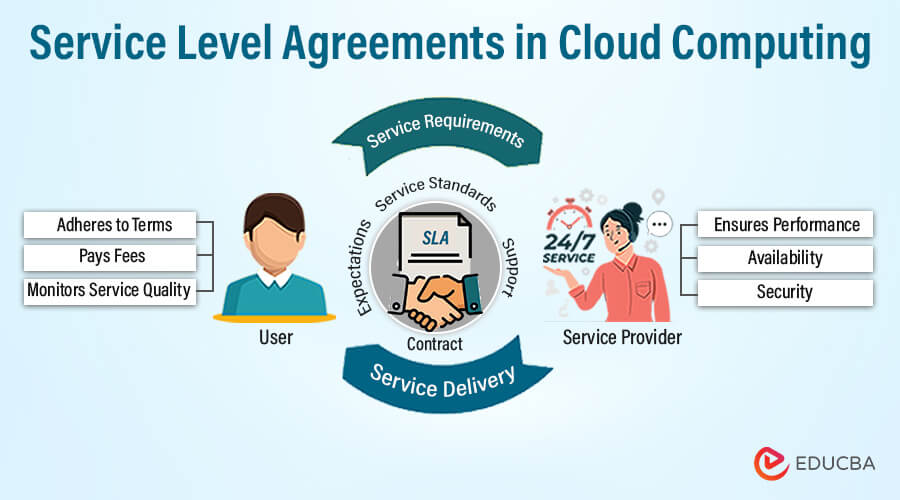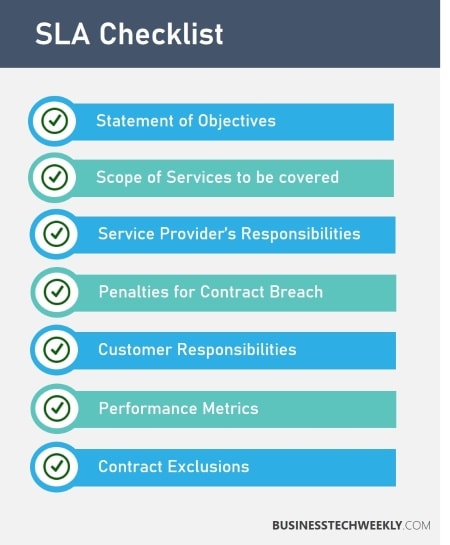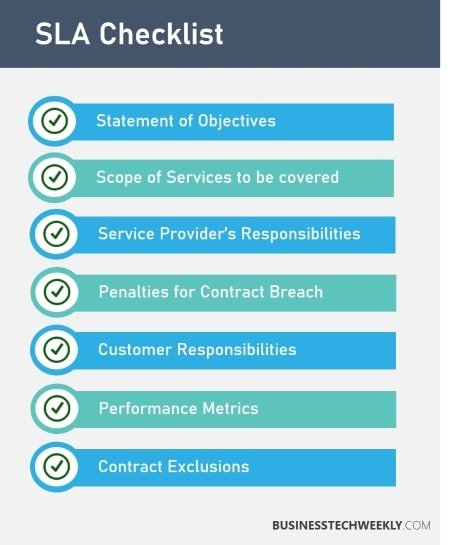
Understanding Cloud Service Level Agreements (SLAs)
Definition of SLAs in Cloud Computing
Cloud Service Level Agreements (SLAs) are formal documents that define the expected service levels between a cloud service provider and its customers. They outline the specific metrics, responsibilities, and expectations involved in the delivery of cloud services. Think of an SLA as a contract that protects both parties while clarifying what each can expect in terms of performance and support.
These agreements typically cover several key aspects, including:
- Service Availability: Minimum uptime percentage.
- Performance Metrics: Response times and transaction processing speed.
- Support Services: Availability of customer support and resolution timeframes.
Understanding SLAs is crucial, especially in a landscape where cloud services are integral to business operations.
Purpose and Significance of SLAs
The primary purpose of SLAs is to establish a clear understanding between the provider and the client regarding the expectations of service delivery. This clarity is significant for several reasons:
- Risk Management: SLAs help mitigate risks and set defined performance benchmarks.
- Accountability: Providers become accountable for the services they deliver, ensuring they meet the agreed standards.
In my experience, having a well-defined SLA is like having a safety net. For instance, a startup I worked with relied heavily on a cloud service for its operations. The SLA detailed that the provider would maintain 99.9% uptime. When an outage occurred, they quickly referenced the SLA, and the provider took responsibility, compensating the startup for the disruption. This clearly emphasizes the importance of SLAs in safeguarding business interests while fostering trust between parties.
By demystifying SLAs, businesses can focus on leveraging cloud solutions to their fullest potential. They can ensure they are not only selecting the right provider but also securing an agreement that truly meets their operational needs.

Essential Components of Cloud SLAs
Service Availability Metrics
One of the cornerstones of any Cloud Service Level Agreement (SLA) is the service availability metric. This metric measures the uptime that a cloud provider guarantees, which is crucial for businesses relying on these services. Commonly expressed in percentages, such as 99.9% uptime, these numbers reflect how frequently the service will be operational.
For example, if an SLA stipulates 99.9% availability, it translates to about 8.76 hours of potential downtime per year. However, even that small percentage can have significant implications for businesses. I recall a case where a retail company experienced a major sales dip during downtime; it underscored the value of this metric in real-world terms.
Performance Guarantees
Performance guarantees outline how swiftly the cloud service operates. This can involve:
- Response Times: The time it takes to process requests.
- Latency Rates: Delays in data transfer.
For instance, an SLA might guarantee a response time of less than 200 milliseconds for application interactions. Such guarantees are vital, especially for companies in sectors like finance, where speed can influence customer satisfaction and retention.
Security and Compliance Standards
With the rise in data breaches and privacy regulations, security and compliance standards have become paramount in SLAs. These provisions ensure that cloud providers adhere to industry regulations, such as GDPR or HIPAA.
Key elements typically include:
- Data Encryption: Ensuring data is secure at rest and in transit.
- Access Controls: Defining who can access sensitive information.
As a personal anecdote, a company I consulted for made it essential in their SLA to have robust security measures, leading to a stronger trust relationship with their clients.
Support and Response Times
Finally, support and response times are critical components of SLAs. This aspect defines how quickly the provider will respond to service issues or inquiries, typically categorized by severity levels.
Consider the following:
- Critical Issues: Response within 30 minutes.
- Moderate Issues: Response within 2 hours.
- Low Priority Issues: Response within 24 hours.
Establishing clear expectations around support can make all the difference, especially during an incident. I remember working with a company that was able to resolve a critical issue swiftly due to having a dedicated support clause in their SLA, highlighting the importance of responsive support.
In conclusion, understanding these essential components is vital for businesses to maximize their cloud investment and ensure they select the right service provider for their needs. Each element works together to create a robust, reliable framework for service delivery.

Evaluating Cloud SLAs
Considerations Before Signing an SLA
Before diving into signing a Cloud Service Level Agreement (SLA), there are several crucial considerations to ponder. First and foremost, it’s vital to clearly understand your business requirements. Take some time to evaluate:
- Service Dependence: How critical is the cloud service to your operations?
- Regulatory Requirements: Are there specific compliance issues your business must adhere to?
- Scalability Needs: Will the SLA support your potential growth?
For instance, during my interaction with a fintech startup, they discovered that their rapid growth necessitated a flexible SLA that could scale with their operations. An overly rigid agreement could have stifled their progress, serving as a valuable lesson on the importance of assessing future needs.
Key Performance Indicators (KPIs) to Look For
When evaluating an SLA, it’s essential to identify the Key Performance Indicators (KPIs) that matter most to your business. These KPIs help quantify service expectations, so you’ll want to focus on metrics like:
- Uptime Percentage: The minimum availability guarantee.
- Response Times: Timelines for both support and service restoration.
- Bandwidth and Throughput: Measuring the effective capacity and speed of data transfer.
Consider a scenario where a company closely monitored uptime percentages and latency; they could ascertain the reliability of their service provider more effectively. This proactive approach allowed them to seek adjustments in their SLA when performance dipped below expectations.
Legal and Compliance Aspects
Finally, understanding the legal and compliance aspects of an SLA is crucial. Always read the fine print:
- Liability Clauses: What happens if the provider fails to meet their commitments?
- Data Ownership: Who retains ownership of your data?
- Dispute Resolution: Understanding the process for resolving conflicts.
A specific example that comes to mind involves a client in the healthcare sector. They faced immense regulatory scrutiny. They ensured that the SLA explicitly stated compliance with HIPAA, which safeguarded their data handling practices and offered peace of mind.
In summary, evaluating cloud SLAs involves careful consideration of various factors. By understanding your needs, identifying pertinent KPIs, and addressing legal implications, businesses can forge strong partnerships with cloud providers that align with their strategies and goals.

Challenges and Risks in Cloud SLAs
Potential Pitfalls in SLAs
Despite their importance, Cloud Service Level Agreements (SLAs) can harbor a number of potential pitfalls. One common issue arises from vague language or undefined terms within the SLA, which can lead to misunderstandings. A client of mine once faced this problem when their provider’s SLA had ambiguous uptime commitments. They encountered significant downtime, yet the provider argued that they met “industry standards” since the term was not clearly defined in the document.
Other pitfalls include:
- Inadequate Coverage: Some SLAs may not cover critical aspects, such as data security or disaster recovery protocols.
- Overly Complex Language: Legal jargon can make it challenging for businesses to grasp their rights and responsibilities fully.
Managing Expectations and Risks
Managing expectations is paramount when it comes to SLAs. Businesses should not only understand their obligations but also know what to anticipate from their cloud provider. Misaligned expectations can result in frustration and lost productivity.
To mitigate this risk, consider the following:
- Regular Communication: Maintain open lines of communication with your provider regarding performance and areas of concern.
- Frequent Reviews: Regularly revisit the SLA to ensure it continues to meet your changing business needs.
During my experience with a mid-sized e-commerce company, I noticed that proactive communication with their cloud provider helped bridge gaps in expectations, resulting in a smoother working relationship.
Strategies for Mitigating Risks
To further safeguard against potential risks, businesses can adopt several strategies:
- Thoroughly Review SLAs: Engage legal counsel to analyze key components of the SLA before signing.
- Establish Exit Strategies: Ensure the SLA outlines clear terms for termination to avoid being stuck with a provider who fails to meet their commitments.
- Monitor Performance: Regularly track performance metrics to ensure compliance with established SLAs. Implementing robust monitoring tools can provide early warning signs of deviations.
By acknowledging these challenges and actively working to mitigate risks, businesses can more effectively navigate the complexities of cloud SLAs. This proactive approach not only fortifies partnerships with cloud providers but also ensures business continuity in an increasingly data-driven world.

Best Practices for Negotiating Cloud SLAs
Setting Realistic Expectations
When negotiating a Cloud Service Level Agreement (SLA), the first step is to set realistic expectations. It’s important to be pragmatic about what your business can require from the cloud service provider while considering their capabilities.
A few points to consider:
- Understand Your Needs: Evaluate your business’s operational requirements and set service levels accordingly.
- Benchmarking: Compare potential SLAs against industry standards; this helps establish what’s realistic and feasible.
For instance, I worked with a team at a software development firm that aimed for 100% uptime. The provider explained the impracticality of this expectation for most services. They compromised on a 99.9% uptime with stronger nuances on redundancy. This compromise not only managed expectations but also created a more robust agreement.
Customizing SLAs for Specific Needs
Customize SLAs to address your unique business needs. A one-size-fits-all approach often fails to account for the nuances of individual organizations.
Some customization strategies include:
- Tailored Metrics: Include specific performance metrics relevant to your industry, such as data retrieval times for a data-centric company.
- Additional Services: If security is paramount, incorporate guarantees around encryption and compliance with regulations specific to your sector.
A telehealth organization I consulted for modified their SLA to highlight critical uptime requirements for their patient-facing application—an essential feature as their services involve real-time interactions.
Establishing Communication Channels
Lastly, establishing clear communication channels is vital during SLA negotiations. Open dialogue can prevent misunderstandings and foster collaboration.
Consider these effective practices:
- Dedicated Contacts: Assign specific representatives for both parties to facilitate swift information flow.
- Regular Check-ins: Schedule periodic meetings to review SLA performance and address any evolving concerns.
For example, in my experience with an e-commerce platform, consistent communication regarding order processing metrics led to swift resolutions of performance issues. This open approach not only strengthened the provider relationship but also ensured the business could meet its customer service commitments.
In conclusion, by setting realistic expectations, customizing SLAs, and fostering effective communication, businesses can negotiate agreements that cater well to their operational needs while minimizing risks. This foundational work establishes a solid partnership between the business and cloud service provider, ensuring long-term success.

Case Studies and Examples
Successful Implementation of Cloud SLAs
Examining successful implementations of Cloud Service Level Agreements (SLAs) can provide valuable insights for businesses looking to enhance their cloud strategies. One compelling example is that of a multinational retailer that adopted a cloud-based inventory management system.
Prior to moving to the cloud, they faced challenges with stock discrepancies, leading to lost revenue during peak shopping seasons. By setting clear SLAs that included:
- 99.9% uptime guarantees: Ensuring their inventory data was always accessible.
- Speedy response times: Committing to resolving critical issues within 30 minutes.
As a result, the retailer experienced a 20% reduction in stock outages and significantly improved customer satisfaction, directly impacting their bottom line. The proactive monitoring and regular communication established through the SLA further reinforced their confidence in the service provider.
Lessons Learned from SLA Failures
On the flip side, exploring failures in SLA implementations can highlight crucial lessons. A well-known healthcare provider faced severe backlash after their cloud provider experienced periodic downtimes. The SLA, however, included loosely defined language regarding “acceptable downtime,” leading to lingering confusion.
Key takeaways from this case include:
- Importance of Clarity: Vague definitions of terms can lead to disagreements and frustration. Clear and specific language is essential.
- Regular Review and Adaptation: The healthcare provider learned the hard way that SLAs should be living documents, regularly revisited to ensure they match evolving business needs.
From this example, it’s clear that ensuring clarity and adaptability within SLAs can make a world of difference. Another aspect to consider is the provider’s accountability; by not including stringent performance metrics, the healthcare facility found itself at a disadvantage.
In summary, successful implementations of cloud SLAs can significantly boost business performance, while failures can provide valuable lessons. By learning from these case studies, businesses can make informed decisions that foster strong partnerships with their cloud service providers and enhance their operational frameworks.

Future Trends in Cloud SLAs
Evolving SLA Standards
As the cloud computing landscape continues to evolve, so too do the standards surrounding Cloud Service Level Agreements (SLAs). Increasingly, organizations are looking for more comprehensive and flexible agreements that reflect their unique operational needs. This shift is driven by advancements in technology and changing customer expectations.
Key trends include:
- More Granular Metrics: Businesses are pushing for detailed performance indicators tailored to specific services rather than broad averages. For instance, a financial services company might require minimum response times for transaction processing as part of their SLA.
- Focus on Security: With cyber threats becoming more prevalent, security guarantees within SLAs have gained importance. It’s no longer sufficient for SLAs to just cover uptime; they must also include commitments around data protection and compliance with regulations like GDPR or HIPAA.
As a practical example, a tech startup I consulted for recently renegotiated their SLA, embedding detailed security metrics that would ensure their customer’s data integrity during transactions. This proactive approach not only built customer trust but also enhanced compliance assurances.
Predictions for the Future of Cloud Service Level Agreements
Looking ahead, we can anticipate several predictions regarding the evolution of Cloud SLAs:
- Automated Monitoring and Reporting: Many providers will adopt AI-driven tools for real-time monitoring, enabling transparent performance reporting that keeps businesses informed without manual intervention.
- More Flexible Contracts: As businesses demand adaptability, we should expect to see more dynamic SLAs that allow for adjustments based on performance analyses and changing needs.
- Enhanced Partnerships: The relationships between providers and customers will become more collaborative, as organizations seek partnerships that prioritize shared success rather than simply transactional relationships.
A notable instance of this evolving trend is seen in the collaboration between a large cloud provider and enterprises, where both parties co-develop metrics that align with each individual organization’s strategic goals.
In summary, the future of Cloud Service Level Agreements is poised for innovation and increased specificity. By embracing these evolving standards and anticipating future trends, businesses can better protect their interests, ensuring that they select cloud providers who align with their dynamic operational landscapes. This proactive approach fosters strengthened partnerships and sets a roadmap for achieving shared success in the cloud-driven future.

